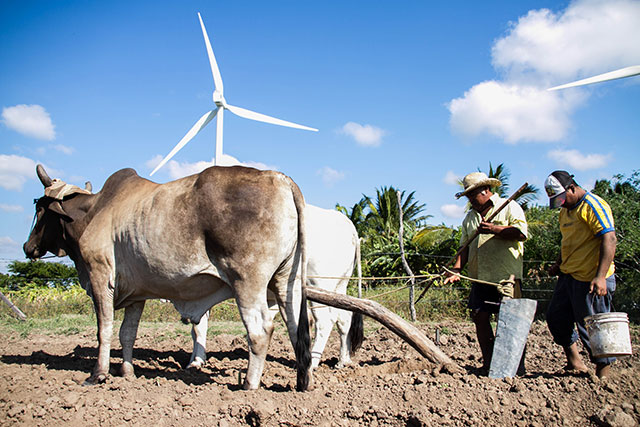
A palm hat worn down by time covers the face of Celestino Bortolo Teran, a 60-year-old Indigenous Zapotec man. He walks behind his ox team as they open furrows in the earth. A 17-year-old youth trails behind, sowing white, red and black corn, engaging in a ritual of ancient knowledge shared between local people and the earth.
Neither of the two notices the sound of our car as we arrive “because of the wind turbines,” Teran says. Just 50 meters away, a wind farm has been installed by the Spanish company Gas Natural Fenosa. It will generate, at least for the next three decades, what governments and energy companies have declared “clean energy.”
Along with this farm, 20 others have been set up, forming what has come to be known as the wind corridor of the Isthmus of Tehuantepec, located in the southern Mexican state of Oaxaca. The corridor occupies a surface area of 17,867.8 hectares, across which 1,608 wind turbines have been installed. The secretary of tourism and economic development of Oaxaca claims that they will collectively generate 2,267.43 megawatts of energy.
“Before, I could hear all the animals living in the areas. Now, it seems the animals have left due to the wind turbines.”
The Tehuantepec Isthmus stretches just 200 kilometers from the Pacific to the Atlantic Ocean, making it the third narrowest strip of land connecting the Americas, after isthmuses in Nicaragua and Panama. In this area, mountains converge to create a geological tunnel, which funnels extremely high-speed winds between the two oceans. Energy investors have focused on the region after the government of Oaxaca claimed that it’s capable of producing 10,000 megawatts of wind energy in an area of 100,000 hectares.
“Before, I could hear all the animals living in the areas. Through their songs and sounds, I knew when it was going to rain or when it was the best time to plant,” Teran said with sadness and rage in his voice. “Now though, it seems the animals have left due to the wind turbines.”
What Teran does not know is whether the turbines, built in accordance with the Clean Development Mechanism (CDM), as defined in the Kyoto Protocol, are generating alternative energy that will actually help to reduce the greenhouse gas emissions of large corporations and industrialized countries. The main objective of these polluters is to prevent global temperatures from rising 2 degrees Celsius before 2100, according to the 21st Session of the Conference of the Parties to the UN Framework Convention on Climate Change (UNFCCC), better known as the COP21, which concluded in December 2015. “I don’t know what climate change is and neither do I know about the COP. I only know that our ancestral lands are being covered by these turbines,” Teran said.
At the Earth Summit held in Rio de Janeiro, Brazil, in 1992, participating countries passed the UNFCCC in response to climate change. With this accord, states set out to maintain their greenhouse gas emissions at the levels reached in 1990. At the third Conference of the Parties (COP3), held in Japan in 1997, the Kyoto Protocol was approved by industrialized countries, with the aim of reducing national emissions to an average of 5 percent below the 1990 levels, between 2008 and 2012. In order to help reduce the costs of this reduction, three “flexibility mechanisms” were designed: emissions trading, joint implementation and the aforementioned Clean Development Mechanism (CDM), under which a large number of the wind farms in the Tehuantepec Isthmus have been constructed.
According to the Kyoto Protocol, these mechanisms are meant to permit industrialized countries and private companies to reduce their emissions by developing clean energy projects in other parts of the world where it is more economically viable, and later include these reductions into national quotas. The second period of engagement of the Protocol is 2013-2020. In this period, countries in the European Union (excluding Iceland) have agreed to a collective emission reduction of 20 percent with respect to 1990 emission levels.
The Clean Energy Extraction and Energy Transition Financing Law states that Mexico will install technology to generate 25,000 megawatts of clean energy by 2024. “Mexico has an obligation to limit the electrical energy generated by fossil fuels to sixty-five percent (from the current eighty percent) by 2024,” the law states.
Teran continues sowing his corn while we ask him about the benefits he’s gained from the wind corridor and, a bit irritated, he responds: “They have not provided me or anyone in my family a job, and I don’t want anything to do with these companies or the government; I just want them to leave me in peace on my land. To let me live as I did beforehand.”
Wind Farms for Sale
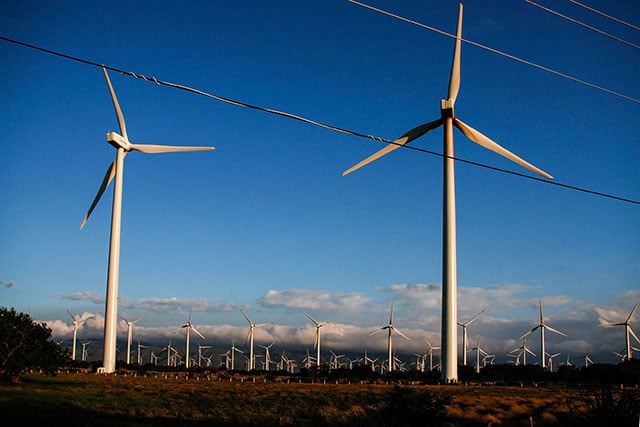 Most wind turbines are stained with lubricants in the blades and in the engine. (Photo: Santiago Navarro F.)
Most wind turbines are stained with lubricants in the blades and in the engine. (Photo: Santiago Navarro F.)
The US Department of Energy and the US Agency for International Development (USAID), with the justification to help accelerate the use of wind energy technologies in the state of Oaxaca, developed an atlas published in 2003, which mapped the wind potential in the state of Oaxaca. The mapping confirms that the isthmus is the region with the largest wind potential.
“This wind resource atlas is an important element of the Mexican strategy to ensure availability of the necessary information and to define specific renewable energy projects as well as tools access to financing and development support,” according to the atlas document.
The paper organizers say they will not share specific maps related to the respective areas of wind potential due to the confidentiality required in possible contracts signed between companies and the government of Mexico. Although more than a decade later, with the arrival of more parks in this territory, it has become clear which of these sites are mainly located on the shores of Laguna Superior.
“Clean energy is part of the continuity of the exponential economic growth of capital.”
For all the good intentions the United States had to cooperate with Mexico to invest in renewable energy, USAID made another document in 2009, called “Study of Export Potential Wind Energy of Mexico to the United States,” which confirms that the greatest potential of this energy is concentrated in the states of Oaxaca (2,600 megawatts) and Baja California (1,400 megawatts). In August 2015, the government of Mexico officially announced that the wind farm “Energía Sierra Juárez” in Baja California, the first wind project between Mexico and the United States, will export energy to California. And they are waiting for an interconnection to export the energy produced in the Isthmus of Tehuantepec.
“This mapping is only one part of a series of mega-projects that are designed for this area,” said biologist and coastal ecology and fishery sciences professor and researcher Patricia Mora, of the Interdisciplinary Research Center for Integral Regional Development of Oaxaca (CIIDIR Oaxaca) based at the Instituto Politécnico Nacional.”Not only is it wind energy, but also oil and gas, and also mining, an infrastructure for the movement of goods. Therefore, this wind mapping is only a pretext to map the full potential of this whole geostrategic area, which functions as a type of catalog to offer it to businesses.”
The wind corridor was designed from the North American Free Trade Agreement (NAFTA), signed in 1994 by Mexico, the United States and Canada, subsequently given continuity with the international agreement, Plan Puebla Panama (PPP), and now remade into Proyecto Mesoamerica. The project’s main objective was to “create favorable conditions for the flow of goods, oil, minerals and energy.”
“Clean energy is part of this context. It’s part of the continuity of the exponential economic growth of capital; it is not something alternative to it. It’s another link that is painted green,” Mora said.
Not-So-Clean Energy
 Two-hundred kilometers connect the Pacific Ocean with the Atlantic. Photo archive of the first consultation that occurred in the Isthmus, specifically regarding Southern wind farm.
Two-hundred kilometers connect the Pacific Ocean with the Atlantic. Photo archive of the first consultation that occurred in the Isthmus, specifically regarding Southern wind farm.
To set the turbines, hundreds of tons of cement that interrupt water flows are used. “It is worth mentioning that they are using the cement company Cemex, who also has a wind farm in the Isthmus,” Mora said.
The population of Venta, where the first wind farm was built, was literally surrounded by turbines. Insufficient with the already installed complex, under the argument of self-sufficiency and with a capacity of 250 megawatts, the park called Eurus, built in 2009, was auctioned off with capital from the Spanish company Acciona and transnational construction materials company Cemex.
It seems that Cemex is the role model of the CDM, a clean and responsible company that has registered several projects this way. In its 2013 report, Cemex boasts of expanding their projects with the CDM model. “Six new initiatives were registered as CDM in 2013, which include four alternative fuel projects in Mexico and Panama and two wind farms located in Mexico, among those Eurus and Ventika.”
In 2015, the Eurus wind farm won the prize awarded by the Inter-American Development Bank (IDB Infrastructure 360°) in the category of “Impact on Population and Leadership,” which recognizes outstanding sustainability practices in infrastructure investments in Latin America and Caribbean.
In February 2015, community activists from the organization Defenders of the Earth and Sea announced, “about 150 wind turbines owned by Acciona and located in the Eurus wind farm and Oaxaca III, have spilt oil, from the blades and main coil, which has polluted the ground and the water, affecting several farmers and ranches surrounding the area.”Both wind farms have 1,500-megawatt turbines, which need 400 liters of synthetic oil, while the 800-megawatt turbines only need 200 liters of oil per turbine per year.
The Costs of Clean Energy
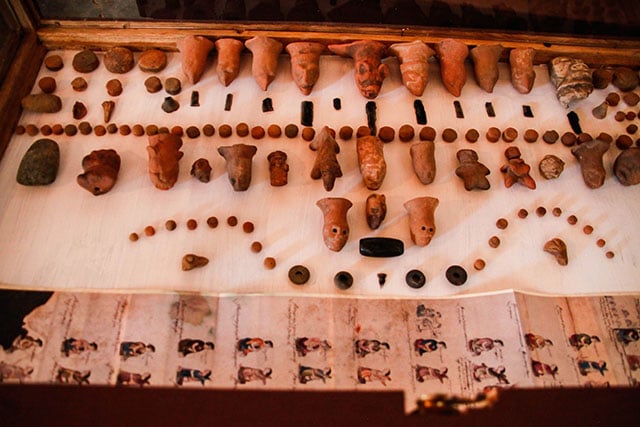 Archaeological remains found by farmers on their land. (Photo: Santiago Navarro F.)
Archaeological remains found by farmers on their land. (Photo: Santiago Navarro F.)
The dominant development model in the production of electricity from wind power in the Tehuantepec Isthmus is stated as a formula in which everyone wins – the government, developers and industry. The model has been of self-supply, in which a private developer of wind power generates energy production contracts for a wide portfolio of industrial customers (Coca-Cola, Cemex, Walmart and Bimbo, for example) for a certain period. In this way, companies can set prices lower than the market for the long term, and separately they enjoy the financial benefits of carbon trading, which on one hand, allows them to continue polluting and, secondly, to speculate on the sale of these pollution permits to other companies. Developers can access financing schemes for “green” projects through organizations like the Inter-American Development Bank and the Clean Development Mechanism (CDM) of the UN.
The communities are also presented as winners in these projects for the development of self-sufficiency and the income they receive from the lease of their land.
Why the Resistance?
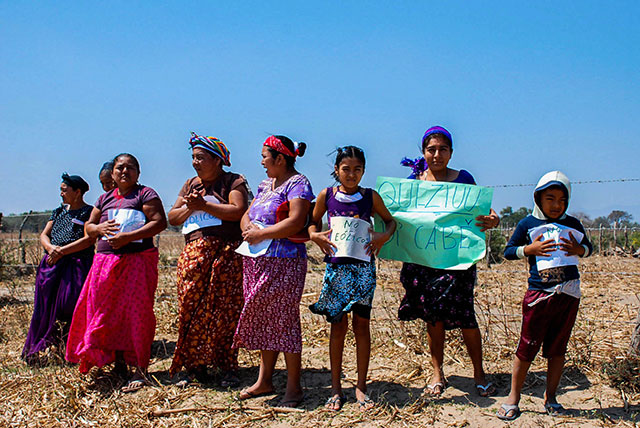 Community women demonstrate against the wind projects on their ancestral land. (Photo: Santiago Navarro F.)
Community women demonstrate against the wind projects on their ancestral land. (Photo: Santiago Navarro F.)
In November of 2012, the consortium Mareña Renovables set out to build the largest wind farm in Latin America in the Barra de Santa Teresa, in San Dionisio del Mar, Oaxaca. The Barra is a strip of land between two lagoons that connects to the sea in the Isthmus of Tehuantepec. Here the Indigenous community of Binni Záa (Zapotec) and Ikojts (Huave), together with the community of Alvaro Obregon, opposed and blocked all access to this strip of land. In response, the state sent about 500 troops from the state police to unblock access, acting with extreme violence. The Indigenous community resisted until the government suspended construction of the wind park. In response to constant harassment and persecution,the Alvaro Obregon community created a community police force called “Binni Guiapa Guidxi” on February 9, 2013.
What was known as Mareña Renovables has changed its name and its form several times. The Spanish energy company, the Preneal Group, which had signed exploration contracts and obtained permits from the state government, sold the rights to the project for $89 million to FEMSA, a subsidiary of the Coca-Cola Company and the Macquarie Group, the largest investment bank in Australia. These companies quickly sold part of their stakes to Mitsubishi Corporation and Dutch pension fund PGGM, signing at the same time a power purchase agreement with FEMSA-Heineken for 20 years.
They also sought to speculate with the reduction of 825,707 tons of carbon dioxide a year, equivalent to the emissions of 161,903 cars.
“Mother Earth is sick; the disease is global warming. They want to profit with the same disease that they have caused to Mother Earth,” said Carlos Sanchez, a Zapotec activistwho participated in the resistance against the installation of the wind farm in Barra de Santa Teresa Park and the installation of a park by Gas Natural Fenosa in Juchitan de Zaragoza.”Under the pretext of reducing global warming, they come to our territories to control our forests, mountains, our sacred places and our water.”
Sanchez is also founder and member of the community radio station Totopo, created to report on mega-projects in the region of the Isthmus of Tehuantepec. During an intermission of his radio programming, we asked Sanchez about what the Zapotec people know about the CDM. “It is a discourse between businessmen. They are labels exchanged between companies to justify their pollution and do not explain anything to Indigenous peoples,” he said.
“Could we, with our forests, also sell carbon credits, bypassing these companies? Who will buy?” Sanchez asked. “It is no coincidence that only those who understand these mechanisms are the only ones who benefit as employers and the state.”
He added, “We do not even benefit from the energy produced. If you walk by the communities you will notice what the clean development they have brought consists of, and I challenge one of the owners of the companies to see if they want to live in the midst of these turbines.”
Following the demonstrations made by Indigenous peoples on May 8, 2013, the secretary of tourism of the state of Oaxaca, José Zorrilla Diego, announced the cancellation of the proposed Renewable Mareña in the Barra de Santa Teresa. Shortly after the announcement of the cancellation, the state government said the project would continue in other areas of the isthmus.
Human Rights Violations and Perspectives
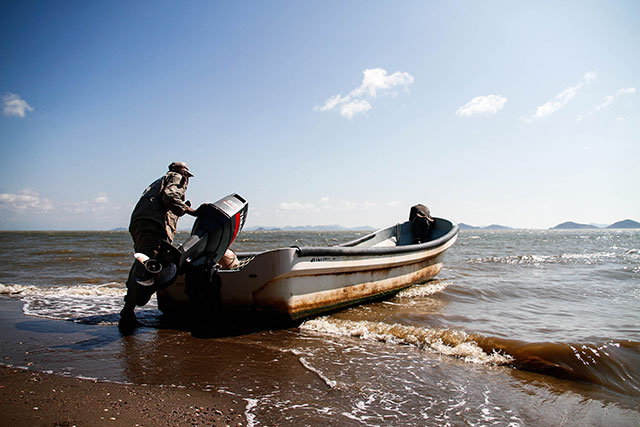 The fishermen on San Vicente beach have already begun to notice changes caused by the wind turbines. (Photo: Santiago Navarro F)
The fishermen on San Vicente beach have already begun to notice changes caused by the wind turbines. (Photo: Santiago Navarro F)
Community organization against the wind farm in the Barra de Santa Teresa was the first major resistance against the ways in which these companies are developing their projects on the Isthmus of Tehuantepec. Sanchez reports that, not coincidentally, it is in this period that the companies began hiring hit men, with the backing of the state.”We see gunmen escorted to the state police. Some of us have been persecuted with absurd lawsuits, accusing us of kidnapping, attacks on the roads, and damage to other people’s private property. The radio station has undergone several attempts at closing, with the invasion of the federal police and Navy,” Sanchez said.
Sanchez reports that since 2013, he does not go to public places. His mobility is restricted to the community. “We endorse the protection mechanism of the Ministry of Interior. But we have realized that their task of protection has been given to the state police, the same people who attacked us. I do not know whether they have come to protect me or arrest me. So I rejected this protection mechanism and started a small personal protection protocol,” Sanchez said. “The state supports the wind companies,” he added.
The Committee for the Integral Defense of Human Rights Gobixha (CódigoDH) Oaxaca demanded the immediate intervention of the federal and state governments to stop the wave of violence against supporters of the Popular Assembly of the People of Juchitan who have been victims of threats, harassment, persecution and attacks, including the murder of one of its members. This followed the conflict rooted in the construction of the Bii Hioxo wind farm, according to CódigoDH. But there was no response.
The company Gas Natural Fenosa rejects the accusations, ensuring, “While certain groups have filed several allegations regarding violations of human rights of communities affected by the project, Gas Natural Fenosa says they are unfounded, that they lack objective justification, and are incompatible with the commitments made by the company’s Human Rights Policy.”
New Strategy, New Park, Old Problems
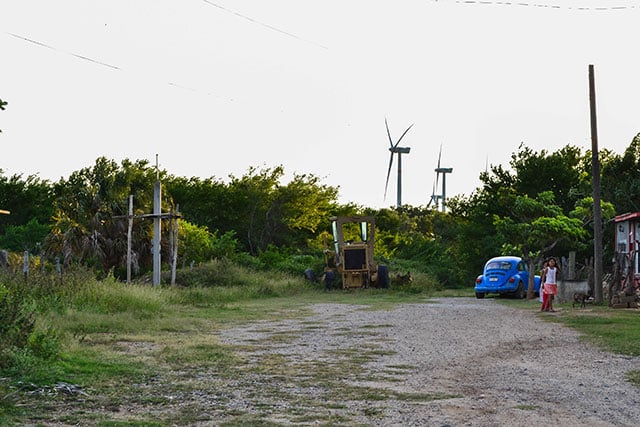 Many homes have been surrounded by wind farms across the Isthmus of Tehuantepec. (Photo: Renata Bessi)
Many homes have been surrounded by wind farms across the Isthmus of Tehuantepec. (Photo: Renata Bessi)
It did not take long for the government’s 2013 promise – to relocate the project from the Barra de Santa Teresa toward another zone in the Isthmus of Tehuantepec – to take shape. In 2014, the company Mareña Renovables, now called Eolica del Sur (Southern Wind), found a new place to develop clean energy and contribute to the goals of reducing greenhouse gases in Laguna Superior.
In 2016, the project foresees the installation of 132 wind turbines of three megawatts each in an area of 5,332 hectares, avoiding the emission of 879,000 tons of greenhouse gases per year, according to the company.
An independent report released by researchers from different fields and universities points out various inconsistencies in the environmental impact study submitted by the company and approved by the Secretariat of Environmental and Natural Resources (SEMANART).
The first contradiction is in regards to the company that made the study. The company responsible is Especialistas Ambientales (Environmental Specialists). And according to the constitutive act of the company, it was possible to determine that the founding partner is the engineer Rodolfo Lacy Tamayo, current undersecretary of planning and environmental policy of the SEMANART.
The document warned that there are many inconsistencies with respect to the surface of Baja Espinoza Forest (Selva Baja Espinosa), which is to be cleared for the construction of this project. Evaluating the information available on the environmental impact statement’s (EIS) own field research, “our analysis shows that the developer intends to cut 100% of the tree surface without proposing any measure of compensation.”
“This is particularly worrying,” according to the document. “The Selva Baja Espinoza connecting the Priority Marine Regions: Continental Shelf Gulf of Tehuantepec, and Upper and Lower Laguna; and Terrestrial Priority Regions: Northern Sierras of Oaxaca Mixe and Zoque-La Selva Sepultura.”
According to Eduardo Centeno, director of the Eolica del Sur company, the EIS is submitted in accordance with Mexican law and contains mitigation measures and preventive measures for the environment, including reforestation.
Another concern of communities is in relation to water pollution in the lagoon and sea area as a result of the oil that will drain on the beaches – 300 liters per wind turbine. Biologist Genoveva Bernal of SEMANART explains that the institution responsible for approving the EIS says the park will not affect Laguna Superior at 3.9 kilometers. “With this distance, it will not have an impact,” Bernal said.
Biologist Patricia MORA discusses the damage caused by lubricants used in wind turbines from Santiago Navarro F. on Vimeo.
Alejandro Castaneira, professor and researcher at the National School of Anthropology and History, who participated in the creation of the report, says the SEMANART authorized an environmental impact study that was wrongly produced. “It is announced that parks are generating clean energy. Are we going to use clean energy to produce Coca-Cola and Lay’s chips while poverty continues?” Castaneira said.
A Far From Participatory Process
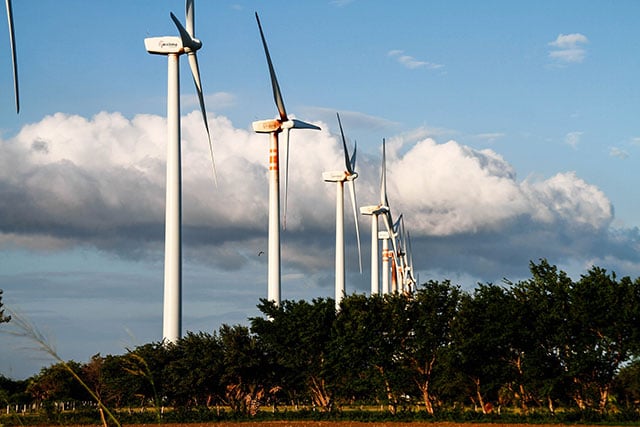 There is currently no established wind farm that respects biodiversity. (Photo: Renata Bessi)
There is currently no established wind farm that respects biodiversity. (Photo: Renata Bessi)
After the events of 2013, Eolica del Sur and the state convened for the first free, prior and informed consultation, under Convention 169 of the International Labor Organization for Indigenous peoples, 22 years since the arrival of the first wind farm in Isthmus of Tehuantepec. This consultation was initiated in November 2014, and completed in July 2015, and is regarded as an essential element for the project to become effective.
On the one hand, both the federal and state governments (as well as the company) claim that the consultation fulfilled its role, which justifies the project, since most of the participants approved. On the other hand, there is enormous pressure for the cancellation of the same consultation because of the irregularities.
At a press conference, Bettina Cruz Velázquez, a member of the Assembly of Indigenous Peoples of the Isthmus of Tehuantepec in Defense of Land and Territory, said that the consultation was carried out after local and federal permits and approvals of land use had already been given by authorities. This shows the federal government’s decision to strip Binni Záa(Zapotec) of its territory. “The consultation is a simulation. They do not respect international standards,” Cruz Velázquez said.
A petition for relief was filed for the 1,166 Indigenous Binni Záa in order to protect Indigenous rights and defend their territory against the wind project. On September 30, 2015, the judge issued an order to suspend all licenses, permits, goods, approvals, licenses and land use changes granted by federal and local authorities, until the final judgment is issued.
“The state allows these projects on the one hand, allowing all the state and federal agencies to expedite permits,” said lawyer Ricardo Lagines Garsa, adviser to the community. “Yet Indigenous peoples are not aware of these legal proceedings, so that they can actually participate in decisions. The whole isthmus territory has been divided between companies [due to] the lack of awareness of the peasant and Indigenous communities who live here.”
Who Benefits From “Clean” Energy?
According to documents from the Commission for Dialogue with the Indigenous Peoples of Mexico, international experience has shown that remuneration paid by energy companies erecting wind farms on leased land oscillates between 1 and 5 percent of the gross income of the energy produced by the turbines. “However, the case of Mexico is drastically different if you take into account the much lower value compared to international standards: here, remuneration is between .025 and 1.53% [of gross income].”
The Tepeyac Human Rights Center states that “because there is no organization that regulates the value of land in Mexico, energy companies pay landowners far less than the actual value, which can provoke tension in communities in which wind farms are set up.”
The criteria that have been used to justify the implementation of wind parks in Mexico as a means of reducing greenhouse gas emissions, as well as total energy production, are insufficient to determine the benefits, risks and broader implications of wind energy production, according to the Commission for Dialogue with the Indigenous Peoples of Mexico. “The criteria ignore or underestimate the complexity and cognitivist and ethical uncertainty of the risks and impacts created by wind parks on a large scale,” the commission stated. “They cannot be seen as a viable energy alternative if they continue to reproduce and deepen socioeconomic and environmental inequalities between countries and between social groups within individual countries.”
Who helps mitigate climate change? From Santiago Navarro F. on Vimeo.
This story was made possible thanks to the Internews’ Earth Journalism Network and produced in collaboration with Armando Carmona. A longer version of this article was published in CIP Americas Program.
Our most important fundraising appeal of the year
December is the most critical time of year for Truthout, because our nonprofit news is funded almost entirely by individual donations from readers like you. So before you navigate away, we ask that you take just a second to support Truthout with a tax-deductible donation.
This year is a little different. We are up against a far-reaching, wide-scale attack on press freedom coming from the Trump administration. 2025 was a year of frightening censorship, news industry corporate consolidation, and worsening financial conditions for progressive nonprofits across the board.
We can only resist Trump’s agenda by cultivating a strong base of support. The right-wing mediasphere is funded comfortably by billionaire owners and venture capitalist philanthropists. At Truthout, we have you.
We’ve set an ambitious target for our year-end campaign — a goal of $250,000 to keep up our fight against authoritarianism in 2026. Please take a meaningful action in this fight: make a one-time or monthly donation to Truthout before December 31. If you have the means, please dig deep.